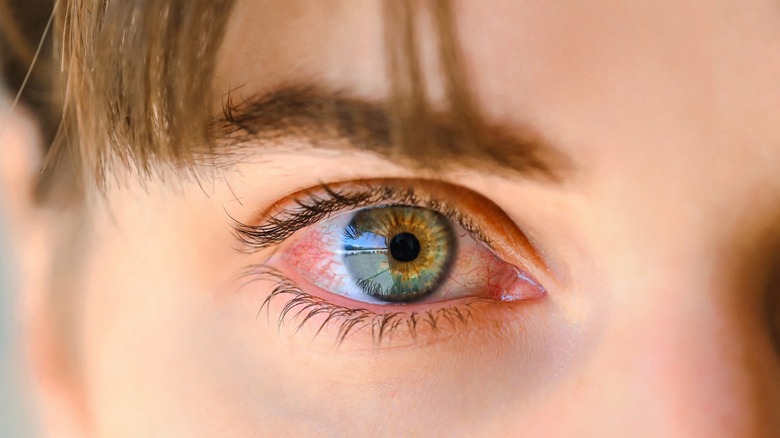How Can You Treat Your Pink Eye At Home?
Pink eye, also known as conjunctivitis, is a common eye condition that affects millions of Americans every year. Cleveland Clinic reports that there are six million cases of pink eye annually in the United States among adults and children. The reason pink eye is so common is that it is highly contagious. In fact, you can have pink eye and spread it before you even realize you have it. Think about how frequently you touch your face or rub your eyes each day — often without even realizing it — and that's how easily you can pick up a case of bacterial pink eye.
But what exactly is pink eye? The experts at Mayo Clinic describe pink eye as an inflammation of the thin, clear mucous membrane that covers the white part of the eye and inside of the eyelid, also known as the conjunctiva. Don't be too surprised if you and others you know have ever had pink eye. Because pink eye is highly transmissible, it can be easily passed to others in a variety of ways, such as through viruses, bacteria, allergens, irritants, and even by coming in contact with someone who has pink eye due to their extensive wearing of contact lenses, per Mayo Clinic.
There are several types of pink eye
There are several types of pink eye, each with its own causes. One of the most common is viral conjunctivitis, which, as the name suggests, is caused by a virus, such as a run-of-the-mill cold or influenza. Viral conjunctivitis is extremely contagious, according to the experts at the Centers for Disease Control and Prevention (CDC). The American Optometric Association (AOA) states that this type of pink eye can be spread easily through coughing, sneezing, or touching the infected eye, and then touching another person or object.
Another type of pink eye, bacterial conjunctivitis, is usually caused by an infection due to Staphylococcus or Streptococcus bacteria. Though this infection often arises from bacteria within your own respiratory system or skin, you can also become infected by coming into contact with insects, unclean hands, or through sharing contaminated cosmetic products, according to the AOA.
Though not technically pink eye and not contagious, allergic conjunctivitis is caused by an allergy to something in the environment. If you have seasonal allergic conjunctivitis, your inflammation is likely due to exposure to outdoor allergens such as pollen or grass, among others. Perennial allergic conjunctivitis can happen any time of year due to pet dander, mold, and other allergens commonly found indoors. Doctors often diagnose allergic conjunctivitis based on your symptoms and an eye examination, according to Johns Hopkins Medicine.
Pink eye: symptoms and treatment
Pink eye symptoms can range from mild to severe. Beyond the pinkish pigment that typically develops in and around the eye, other symptoms of pink eye can include itching, burning, a white or yellowish discharge, crusting around the eyelids or eyelashes, swelling, impaired vision, and increased sensitivity to bright light, among others. And if you're a contact lens wearer with pink eye, you may notice that your lenses aren't fitting correctly or staying in, according to the National Institutes of Health (NIH).
Pink eye can look and feel pretty lousy, so your first instinct may be to seek immediate medical attention, but that isn't always necessary. If you suspect you have pink eye, there are methods you can try first at home that may help. The experts at WebMD provide several suggestions. For example, as a soothing measure, try a warm or cool compress. Apply water on a lint-free cloth, wring it out, close your eyes, and place the cloth gently on the affected eyelid. Make sure to stay clear of the healthy eye so as not to transfer the infection. To reduce itching, there are over-the-counter eye drops available. If you wear contacts keep your lenses out of your eyes until the pink eye clears, otherwise bacteria or viruses can get trapped and re-infect you. If your symptoms continue to persist after a few days, it's a good idea to contact your healthcare provider.



